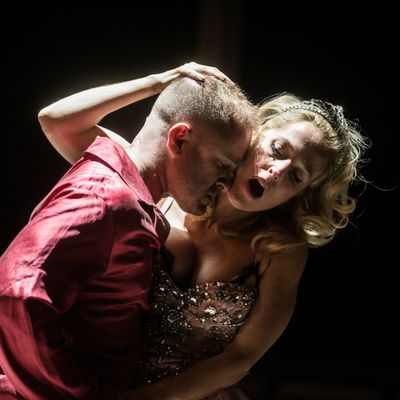
The first thing Blanche DuBois does when she arrives at her sister’s “sort of messed up” flat in New Orleans is to locate the liquor and avail herself of a stiff one. Like many characters in American classics of the period — including nearly everyone in Long Day’s Journey Into Night and Who’s Afraid of Virginia Woolf? — the tragic heroine of Tennessee Williams’s A Streetcar Named Desire will continue to drink throughout the action, almost always lying about it with comments like “one’s my limit.” Even in productions that don’t emphasize the drinking, audiences may begin to wonder whether Blanche’s breakdown is owed to alcohol poisoning, her shakes the DTs. Also, is her brother-in-law Stanley Kowalski just an angry souse or something even more ominous? Productions that do emphasize the drinking — like this one, directed by Benedict Andrews and starring Gillian Anderson at St. Ann’s Warehouse — may make it hard to remember what Williams actually dramatized: how a poetic vision of the old South gets mowed down by the more frankly animal exuberance of the new. He was interested in the collapse of Blanche’s illusions, not the collapse of her liver.
Everything in Andrews’s fascinating yet too-often-unaffecting interpretation — a transfer from London’s Young Vic — aims big but in fact points toward smaller ways of understanding the play. To begin with, the Kowalski apartment is built on a long, narrow platform that revolves continuously, sometimes slowly enough that it takes a whole scene to encompass one revolution and sometimes fast enough to induce a certain amount of Blanche-like tipsiness. (The audience at St. Ann’s is distributed on all sides of the set, so if faces and action are occasionally blocked by a door or a toilet, they never are for long.) However beautifully carried out, and however apt as a demonstration of the lack of privacy in the Kowalskis’ life, the design (by Magda Willi) is prima facie alienating; you study its mechanics, and the smart solutions to the problems it causes, as much as you study the play itself. But this is in keeping with the overall aesthetic, which has the meta quality of a contemporary-art installation that wants you to notice how boldly it’s made and dares you to fathom its contradictions. Andrews settles, for instance, on a kind of period-blind approach, in which the text, with its toothsome 1940s patois, is presented unaltered, but the apartment is apparently furnished by Ikea and the “dial” phone (which Blanche has trouble using) is cordless. Bursts of punk noise (and Chris Isaak crooning!) accompany the scene breaks, scoring obvious points. Was there a concern that the drama would not make sense unless it was rendered instantly recognizable? Most of the costumes (by Victoria Behr) are so contemporary — sister Stella favors T-shirts and gym shorts — that Blanche’s chiffons and tiaras and fox pieces seem by comparison not just outdated but barmy.
You could argue the aptness of that; it’s after all Blanche who says, “I don’t want realism. I want magic.” But Anderson, who looks fantastic and moves through the material with great confidence, has mostly settled, like the production as a whole, on the realism, or really a kind of objectification that borders on charmlessness. She is, from the beginning, inside-out — an obvious drunk and hysteric and liar, instead of covertly so. By the end she is so snockered she seems more likely to injure herself in a fall from her stiletto heels, or just pass out, than to do any permanent psychic damage. Similarly, Ben Foster’s Stanley is so convincingly apelike upon his first appearance that his violence toward Stella and, climactically, toward Blanche, fails to read as an alteration in his character. He has not been pushed to these extremes; he was already there. Of the three principals, only Vanessa Kirby as Stella builds into her performance enough room to let the play’s events change her; although she has the weirdest New Orleans accent ever (unlike Anderson and Foster, she’s English), she is the most affectingly American. She is open to experience.
The play is so phenomenally well written that there is much to gain from even an everted, objet d’art presentation like this one. Few dénouement scenes in American drama have the structural brilliance of Williams’s here, with its awful yet natural juxtaposition of poker and pathos. And the scenes of Blanche’s attempted romance with Stanley’s poker buddy Mitch play, as always, like a mini-classic within the larger one, their hope and hopelessness perfectly calibrated. (Corey Johnson is ideal as the schlubby mama’s boy.) And though Foster’s thin-skinned, adolescent quality undermines Stanley’s sexual chemistry with Stella (not a problem with the role’s originator, Marlon Brando), it helpfully highlights his paranoiac reaction to Blanche. Having him kick her fake Louis Vuitton bag under a cot is a very nice touch.
Still, the production is too indulgent in sweeping away the implications of its choices, beginning with its stars. Foster, at 35, is much younger than the 47-year-old Anderson — a casting trope that is by now traditional, taking Blanche at her word that she is past the last bloom of her youthful beauty. But she’s not Miss Havisham; Williams wrote her as 30, at most a year or two older than Stanley, which makes for a different kind of chemistry. It is emblematic of this Streetcar’s shortcomings that it gets this wrong while getting so much else right. Blanche is not a cougar but a princess, a disaster not of drink or decrepitude but of love.
A Streetcar Named Desire is at St. Ann’s Warehouse through June 4.

